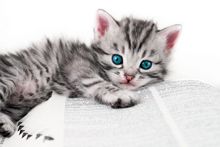Veterinary terms: Lost in translation
Break the code on hospital language and translate some of the fun (and funny) terms in veterinary medicine.

There are certain terms in any profession that are only understood by those in the field. However, in veterinary medicine these terms get to be a bit more entertaining, and sometimes they can be downright comical. It's only fair in a field that can unfortunately bring many difficult, emotional moments that we all try to lighten the mood now and then. Here are a few of those fun terms that only a veterinary professional would understand.
> Better living through chemistry. Embrace the invention of Western medicine's drugs with those fractious cats. When chemical restraint is needed, you may use this euphemism. Less stressful for the cat as well as the veterinary team means better living for all.
> Throw it in “the spinner.” This sounds frightening, but tell pet owners they needn't fret. It's not some sort of medieval treatment. It's a centrifuge! When we call out this phrase, we're most likely asking for a lab sample to be put in the centrifuge and “spun” down.
> Let's put on a ‘party hat.' This happy term keeps Princess the pooch's mother from losing her cool. It sounds much more pleasant to Princess's owners-and it's easier to say in a chipper voice-that we need a “party hat” vs. a muzzle.
> Cat burrito. Ohh … burrito? Yum! This isn't a weird new recipe to tempt kitty's appetite. It's a super helpful technique for controlling unruly kitties in the clinic. You place the cat in the middle of a towel and wrap her up like a burrito, with the dangerous claws and flailing limbs tucked neatly away. You have officially entered the league of veterinary support professionals the day that you have mastered the art of the “cat burrito."
> Cuffer puffer. As educated as we all may seem when we talk to clients, we still use very basic, sometimes even childlike, descriptions in the treatment area. The “cuffer” is the balloon-like cuff that seals the trachea against aspiration of bodily fluids and air leakage. The “puffer” is often a 5 or 10 ml syringe. Therefore, the “cuffer puffer” is the dry syringe that's used to insert air and inflate the endotracheal tube's cuff. Yes, I suppose we could yell out “Get me the air syringe please!” But how much fun is that?
> Dinner and dancing. This one you may have not heard of unless you've worked at a clinic that was heavy into reproductive specialty services. We like to make the whole breeding and artificial insemination process a bit more sophisticated and refined than what it really is by using this term. When you take your pup for “dinner and dancing,” puppies may soon be joining your household.
> Hematomato. OK, at least the actual word we're referencing is within this one. “Hematomato” is a nicer, more pleasant way of describing a hematoma on a patient. “Whoa, we've got a good-sized hematomato growing on Sammy after his blood draw. I need a bandage stat!”
> Yeasty beasties. Oh, so cute sounding, but oh, how gross. “Yeasty beasties” is just a euphemism for those overgrowths of yeast buds we find on ear and skin cytologies.
> Little friends or buddies. This may sound awfully adorable, but this is actually a reference to parasites, and sometimes even yeast or bacteria, found on patients. Often when a technician is evaluating a skin or ear cytology, she may find some “little buddies” that require the addition of an antifungal or antibiotic or antiparasitic medication. Side note: We've also been found guilty of referencing those lingering testicles as Spike's “little buddies.”
> The FIV (Rhymes with “live”). When that SNAP test reveals that dreaded dark dot, it may be said “Oh, no, kitty's got the FIV.” This is not meant in any way to be harsh or insensitive. This just goes back to veterinary team members finding any way of shortening a term to save a few moments in their hectic day.
> Kitty magic. Yes, I love all of those online videos of cats doing magic tricks too. Conversely, this is actually a beautiful drug combination that helps Mr. Socks drift off into the land of pink elephants and allows us to perform that surgical or painful procedure. And its results are truly magical.
> See if he has a bladder. This term is not to be taken literally. We are confident that these patients do in fact have bladders. We are “seeing” via ultrasound, and hoping for enough urine to be present in the bladder that we can safely perform a cystocentesis for urinalysis.
> Well loved. Yes, sometimes this actually just means what it sounds like-a well-cared-for patient. However, we often need to soften the blow for clients when they begin to realize Fluffy could stand to join kitty Weight Watchers. We will sometimes substitute “a little chunky” or “overweight” with “well-loved.” “Fluffy should probably use a few pounds, she is just a bit … how should I say this? … ‘well-loved.' ”
Oriana Scislowicz, BS, LVT, VDT, is a Firstline Editorial Advisory Board member and a technician in Richmond, Virginia. What fun terms does your team use in veterinary practice? Email them to us at firstline@advanstar.com.